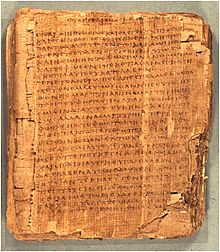- Papyrus 66
-
New Testament manuscripts
papyri • uncials • minuscules • lectionariesPapyrus  66
66
John 7:52; 8:12-16Name P. Bodmer II Text John 1:1-6:11; 6:35-14:26,29-30; 15:2-26; 16:2-4,6-7; 16:10-20:20,22-23; 20:25-21:9,12,17 Date ~200 Found Jabal Abu Mana Now at Bodmer Library, Geneva Cite Martin, Victor. Papyrus Bodmer II: Evangile de Jean 1-14 (1956); Martin, Victor. Papyrus Bodmer II: Evangile de Jean 14-21 (1958); Martin, Victor and Barns, J.W.B. Papyrus Bodmer II: Supplément, Evangile de Jean 14-21 (1962); Aland, Kurt. "Neue neutestamentliche Papyri III" NTS 20 (1974) pp. 357-381 Size 39 folios; 14.2×16.2 cm; 15-25 lines per page Type Free; scribe+major&minor editors Category I Note very close to P75, B, 0162 Papyrus 66 (also referred to as
 66) is a near complete codex of the Gospel of John, and part of the collection known as the Bodmer Papyri.
66) is a near complete codex of the Gospel of John, and part of the collection known as the Bodmer Papyri.Contents
Description
The manuscript contains John 1:1-6:11, 6:35b-14:26, 29-30; 15:2-26; 16:2-4, 6-7; 16:10-20:20, 22-23; 20:25-21:9, 12, 17. It is one of the oldest New Testament manuscripts known to exist, with its writing dated to around 200 CE.[1]
In common with both the other surviving early papyri of John's Gospel; P45 (apparently), P75, and most New Testament uncials, Papyrus 66 does not include the pericope of the adulteress (7:53-8:11)[2]; demonstrating the absence of this passage in all the surviving early witnesses of the Gospel of John. The manuscript also contains, consistently, the use of Nomina Sacra.
Studies done by Karyn Berner[3] and Philip Comfort,[4] contended that
 66 had the work of three individuals on it: The original, professional scribe, a thoroughgoing corrector and a minor corrector. But more recently James Royse argues that, with the possible exception of John 13:19, the corrections are all by the hand of the original copyist.[5]
66 had the work of three individuals on it: The original, professional scribe, a thoroughgoing corrector and a minor corrector. But more recently James Royse argues that, with the possible exception of John 13:19, the corrections are all by the hand of the original copyist.[5]It uses staurogram in John 19:16.
Text
The Greek text of this codex is a representative of the Alexandrian text-type. Aland ascribed it as "Free text" and placed it in I Category.[6]
A transcription of every single page of
 66 is contained in the book referenced in reference[2], pages 388-468.
66 is contained in the book referenced in reference[2], pages 388-468.- In John 1:15 ο οπισω ] ο πισω, the reading is supported by Sangallensis and 1646;[7]
- In John 13:5 it has unique textual variant ποδονιπτηρα instead of νιπτηρα.
- In John 13:7 it has αρ (error) instead of αρτι (now).
History
The manuscript was found in 1952 at Jabal Abu Mana near Dishna (Egypt).[8] In fact, the preservation level of
 66 surprised scholars because the first 26 leaves were basically fully intact, and even the stitching of the binding remained.
66 surprised scholars because the first 26 leaves were basically fully intact, and even the stitching of the binding remained.It was published in 1956 and it was the most important New Testament manuscript publication since the Chester Beatty Papyri in 1933-1934.[9]
It is currently housed at the Cologny-Geneva, Switzerland: Bibliotheca Bodmeriana. The Papyrus contains 39 folios - that is 78 leaves, 156 pages - at a size of 14.2 cm x 16.2 cm for each leaf with roughly 15-25 lines per page.
See also
References
- ^ Herbert Hunger. Zur Datierung des Papyrus Bodmer II (
 66) (1960)
66) (1960) - ^ a b Philip Comfort and David Barrett. Text of the Earliest New Testament Greek manuscripts (Grand Rapids: Baker, 1999.) p. 376.
- ^ Karyn Berner. Papyrus Bodmer II,
 66: A re-evaluation of the Correctors and corrections (MA thesis, 1993)
66: A re-evaluation of the Correctors and corrections (MA thesis, 1993) - ^ Philip W. Comfort. The Scribe as Interpreter: A new Look at New Testament Textual Criticism according to Reader-Reception Theory (1996)
- ^ Royse, pp. 409-21.
- ^ Aland, Kurt; Barbara Aland; Erroll F. Rhodes (trans.) (1995). The Text of the New Testament: An Introduction to the Critical Editions and to the Theory and Practice of Modern Textual Criticism. Grand Rapids: William B. Eerdmans Publishing Company. p. 101. ISBN 978-0-8028-4098-1. http://books.google.com/books?id=2pYDsAhUOxAC&printsec=frontcover&source=gbs_ge_summary_r&cad=0#v=onepage&q&f=false.
- ^ UBS3, p. 321
- ^ Comfort, Philip W.; David P. Barrett (2001). The Text of the Earliest New Testament Greek Manuscripts. Wheaton: Tyndale House Publishers. p. 376. ISBN 978-0-8423-5265-9.
- ^ Floyd V. Filosn, A New Papyrus Manuscript of the Gospel of John, The Biblical Archeologist (Vol. XX), p. 54.
Further reading
- K. Berner, Papyrus Bodmer II, P66: A re-evaluation of the Correctors and corrections (1993).
- Victor M., Papyrus Bodmer II: Evangile de Jean 1-14 (Cologny-Geneve 1956);
- Victor M., Papyrus Bodmer II: Evangile de Jean 14-21 (1958).
- James R. Royse, Scribal Habits in Early Greek New Testament Papyri (Atlanta: Society of Biblical Literature, 2008).
- Comfort, Philip W.; David P. Barrett (2001). The Text of the Earliest New Testament Greek Manuscripts. Wheaton, Illinois: Tyndale House Publishers. pp. 376–468. ISBN 978-0-8423-5265-9.
External links
- Image of p 52 of Papyrus 66 at Bible Research
- "Liste Handschriften". Münster: Institute for New Testament Textual Research. http://intf.uni-muenster.de/vmr/NTVMR/ListeHandschriften.php?ObjID=10066. Retrieved 26 August 2011.
Categories:- New Testament papyri
- 2nd-century biblical manuscripts
- Early Greek manuscripts of the New Testament
Wikimedia Foundation. 2010.


